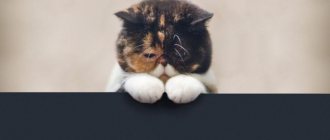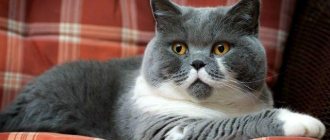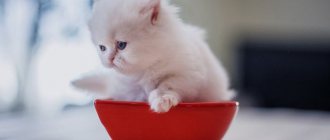The Maine Coon or American raccoon cat is one of the largest breeds of domestic cats, second in weight and size only to the Savannah breed. The weight of adult male coons can reach 10 kilograms with a height of up to 41 cm and a total length with tail of up to 120 cm (tail - up to 36 cm).
Characteristic features are high, voluminous ears with tassels like a lynx, wide oval eyes, a slightly elongated head shape and high cheekbones. And, of course, the special striped color of the thick and fairly long coat, which is why this breed received the prefix “raccoon”.
Story
There are two versions of the origin of the breed. According to the first legend, Maine Coons originated from crossing a cat with a female raccoon. The only evidence here is the similarity of color. But, given the fact that we are talking about representatives of two different suborders of the order of predatory mammals - canines (which includes the raccoon family) and felines, this legend is far from reality.
The second, more plausible legend is the crossing of a cat and a lynx. This is supported by the similarity in color, size, and shape of the Maine Coon’s ears. But this version is not supported by serious researchers; most likely this amazing breed is the result of evolution without exotic crosses.
The breed got its name from the American state of Maine, and its first representative to gain worldwide fame was the cat Captain Jenks, shown in Boston in 1861. At one time, interest in this breed faded; representatives of the Persian breed were more popular in the late 19th and early 20th centuries. But it was preserved thanks to the interest of American farmers who liked the size and hunting qualities of Maine Coon cats. Today this breed is popular in many countries around the world and is a constant participant in various shows and competitions.
Elf, baby and king
Rex cats (Cornish Rex and Devon Rex) are truly animals of royal blood: rex means “king” in Latin. But the most unusual names of cat breeds have appeared quite recently.
Elf is one of the “hairless” cat breeds. Elves have a peculiar shape of ears: they are wide at the base and pointed at the ends. In addition, the tips of the elven ears are curved, which gives the cat’s face a truly “unearthly” expression.
Another “hairless” breed with an unusual name is the Bambino. This breed is the love child of the Canadian Sphynx and Munchkin. Bambinos inherited the absence of fur from the sphinxes, and short, plump legs from the munchkins.
The breed was named bambino because in Italian this word means “child”, “infant”, “child”. Indeed, even an adult bambino is very similar to a small kitten, not only in height, but also in the “expression” of its face.
Thus, you can buy a kitten not only of a “simple” British shorthair or Siberian cat, but even of a “fairytale” elf or “rag doll”.
Key features and appearance
A true, purebred Maine Coon can be distinguished from mixed breeds by some basic characteristics:
- Slightly elongated head shape with an uneven profile and high cheekbones.
- Characteristic tassels on pointed, voluminous ears.
- Wide oval eyes.
- Large muscular body, paws proportionate to the torso.
- Thick long hair, fluffy tail.
- The average length is about 90-100 cm, weight is 7-9 kg (on average) for males, up to 6 kg for females.
See more details about the weight of Maine Coons by month.
Health of Maine Coon cats
Maine coon cats are considered to be fairly hardy and healthy cats, however, like many other breeds, they may develop diseases such as:
- hypertrophic cardiomyopathy
- polycystic kidney disease
- spinal muscular atrophy
- hip dysplasia
Characteristic diseases
Maine Coons are often prone to genetic heart disease. Therefore, it is recommended to undergo periodic heart examinations throughout your life so that you can take timely measures for treatment.
Essential vitamins
Due to the fact that the Maine Coon is a large breed with heavy bones, a kitten needs a source of calcium from birth. For successful growth and development of tissues, vitamins such as “Zhelobin” are suitable. In order to prevent cardiovascular diseases, it is recommended to give vitamins with taurine and biotin.
Castration
The best time to castrate a Maine Coon cat is between 7 and 8 months of age.
After castration, be sure to stay close to the cat: cover it with a soft pillow wrapped in disposable film, and place a heating pad under it.
Estrus
When in heat, the Manx cooncat often rolls on the floor and screams day and night. In addition, the Maine Coon cat, despite its docile nature, can become angry and aggressive at this time.
In most cases, sterilization of this breed at 6-7 months is beneficial - the risk of diseases decreases and attachment to the owners increases.
Pregnancy
The gestation period of a raccoon cat is usually longer compared to other breeds. Pregnancy of Maine Coons reaches 68 days.
Childbirth
Childbirth in Maine Coons is usually easy, without complications. Kittens in a litter come in no more than 6 different colors.
Character and habits
Maine Coon cats are famous for their balanced, flexible character, sociability and non-selfishness. They enjoy spending time with people and love active games. This breed is practically not characterized by rancor; if an overly naughty cat is scolded, it will not take revenge on its owners by damaging curtains or other things.
It is impossible not to note the excellent learning ability and awareness of actions of cats of this breed. It costs them nothing to learn how to open the door by pressing the handle, they are easily accustomed to the toilet, and they can be taught various tricks. A characteristic feature is high curiosity, attention to everything that moves and makes sounds.
Another trait rarely found in cats is an interest in water. Maines love to splash water with their paws, rinse pieces of food with their claws, and even climb into the water and drink straight from the tap. Experts attribute this interest to their original habitat, a large number of bodies of water in Maine.
New in blogs
A raccoon is not a cat at all: How to make friends with a striper and save your fingers at the same time
https://zbulvar.ru/archive/enot-sovsem-sovsem-ne-kot-kak-podruzhitsya-s-poloskunom-i-sberech-pri-etom-paltsy/
The popularity of raccoons on the Internet is off the charts: people post funny photos of their pets and funny videos online. Raccoons are truly hilarious. It is not surprising that many decide to have them. Nikolai Kozlov, Deputy General Director of the Strana Enotia network of petting zoos, told ZB what you need to be prepared for.
Predator in the house The raccoon is a really cute animal. But it is still a predator. And if you decide to have one at home, remember a few simple things. Do not buy a raccoon from an advertisement: most likely, you will be offered an animal from an open-air cage, and such animals are not used to being handled. — I tried to tame a captive raccoon. Despite a higher canine education and many years of experience working with dogs, things didn’t go further than hands that were bitten to the bone when trying to pet them, says Nikolai. In order for a raccoon to be absolutely tame, it is taken from its mother while still blind and fed from a pipette. Then, having opened his eyes in the hands of a person, the baby raccoon begins to perceive him as one of his own for the rest of his life. And the raccoon, although considered an omnivore, is very fastidious in feeding. He must be fed with natural products, and the menu must be balanced: meat, fish, poultry, vegetables and fruits, eggs, honey, etc.
Let him do the laundry! The raccoon is an extremely social animal, much more sociable than a cat. He is very sociable, loves to play with people and with toys, and is constantly on the move. But he sleeps soundly - you won’t wake him up. “Our raccoon, having played enough, climbed onto a horizontally reinforced log and fell asleep with its paws dangling to the sides,” says the specialist. “We stroked him and took him by the paw, but he didn’t wake up!” And then in his sleep he moved and... flew down. You should have seen his bewilderment! He jumped up on his hind legs, spread his front legs wide and looked around for a long time, not understanding what had happened to him. The raccoon loves to splash in the water and “wash” all sorts of rags, so it’s worth keeping a bowl of water in the bathroom. But it’s better if the animal “washes” what you give it yourself. If you are gaping, he will find suitable things himself: on the shelves, in your pockets. Can “wash” your cell phone and “launder” your money. So be on the lookout! And so - 24 hours a day. If you have to leave, put the raccoon in the enclosure and lock it: it can easily open a regular latch or hook. After all, his brushes are almost as dexterous as those of a human. “In our zoo, raccoons constantly steal something from the pockets of visitors,” Kozlov sighs. — Handkerchiefs, wardrobe numbers. And once a raccoon pulled several large bills from a man’s pocket and took them to a corner. At least it didn't break. The man just threw up his hands: why, he says, do you need money, you live on everything ready-made! I had to change: the raccoon agreed to give the money only in exchange for a treat.
If you punish it, it will bite. The raccoon is a very clean animal, it learns very well to use the litter box, like a cat. But you can also walk with him - always on a harness. Often such walks turn into a free show for passersby, the animal can behave so hilariously. “Raccoons are excellent at training, and they perform all sorts of tricks with pleasure,” says Nikolai Kozlov. — They ride a bicycle, “sweep” the floor (they walk on their hind legs with a mop in their “hands” and move it around the corners). But putting pressure on the beast, using the “carrot and stick” method is not suitable. With a raccoon, you only need a “carrot”, only encouragement for a completed command. You can’t punish him: he’ll bite.
He perceives a person not as a leader, but as an equal member of his family, so it is strictly not recommended to leave a child alone with a raccoon. They may start sharing toys, or the raccoon will simply “play”... And raccoons bite professionally - I’ve tested it myself.
Alexey TUMANOV
Health and illness
The American raccoon cat is one of the healthy and hardy breeds adapted to living in northern climates. Statistics show that about 74% of registered cats live for more than 12 years, and more than 50% survived their 16th birthday.
The most common are genetic diseases, in particular dysplasia of one or both hip joints, which is typical for cats of large breeds (including Persian). Most often it manifests itself with age in the form of lameness. The most serious in terms of consequences is hypertrophic cardiomyopathy (HCM), a disease of the cardiovascular system that is common to cats and humans. The result may be sudden paralysis of the hind limbs, pulmonary edema and death. Less dangerous is atrophy of the back muscles, which is expressed by swaying of the back of the body when walking and difficulty jumping. But this does not interfere with a long life as a pet.
Maintenance and care
Caring for Maine Coon cats means, first of all, taking care of his health, timely visits to the veterinarian and having all the necessary vaccinations. It is recommended to vaccinate against ticks, regularly take prophylactic antiparasitic drugs, and take essential vitamins. Like any cat with thick hair, it is necessary to use a special paste to empty the stomach of hairballs, and it is also useful to grow grass that helps in cleansing the digestive organs. It is advisable to comb the coat at least 1-2 times a week.
For nutrition, you can use special food designed for large cats or natural products. With any choice, you need to keep quality and variety in mind. You can feed him lean meat (beef, rabbit, chicken) or boiled lean fish without small bones. It is advisable to supplement the diet with vitamin and mineral complexes, vegetables mixed with meat, kefir, low-fat cream and cheese.
Relationships with children and pets
Maine Coons get along well with children; they are one of the calmest and most forgiving breeds that love active games. Of course, you should not play with the animal for too long and provoke it into active actions. After games you need rest.
Another pleasant characteristic of cats of this breed is their normal relationships with other animals. He will get along well with another cat or dog; their large dimensions and weight allow them not to be afraid of many domestic dog breeds. As for small birds, hamsters, rats and other rodents, such coexistence is undesirable and requires special precautions. Still, the hunting instincts of cats can play an evil role here.
Features of living with other pets
A raccoon kept at home needs attention, which is especially true for individuals who have not entered puberty. If you do not raise an animal from childhood, it will be aggressive and unfriendly. Young animals need to be handled at least 3-5 hours a day; they are individualists and also predators, so they do not get along well with other pets. However, a raccoon can get along with both a cat and a dog - it all depends on the character, conditions of keeping and upbringing of the animals.
Important! The raccoon will not be able to coexist with birds and rodents. The fact is that a predator, driven by instincts, can eat a mouse, hamster, parrot and other small animals that it eats in the wild.











